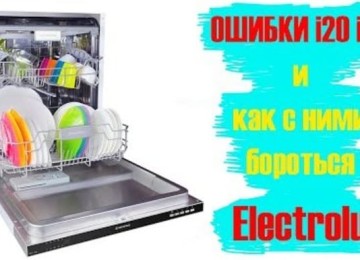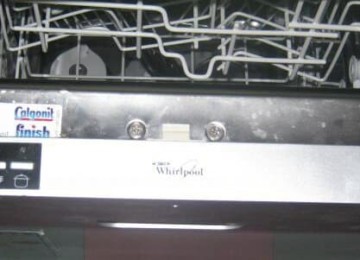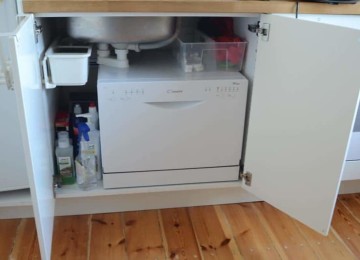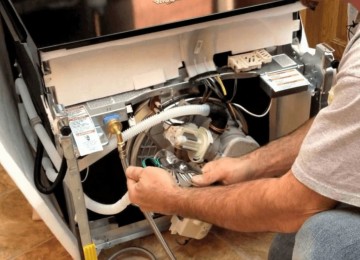Like any household appliance, a dishwasher is designed to save our energy and time, making daily household chores easier. But we must not forget that even if the equipment looks clean, this does not mean that it does not require care and regular cleaning.
The dishwasher is in constant contact with dirty dishes, detergents and water. As a result, food and fat residues, parts of tablets that have not had time to dissolve, accumulate over time in the filters, sealing element and internal surfaces. Lime deposits also appear due to constant contact with water, especially if it is hard. The formation of scale impairs the thermal conductivity of the unit, which increases power consumption. But, in addition to increasing the numbers in the meter, the functioning of the machine itself is also disrupted, and the service life of the device is reduced.
Therefore, in order to prevent premature breakdowns and increase the service life of the dishwasher, you need to clean it periodically. A logical question arises here: what is the best way to clean the device?
You can purchase special products for this, but you can also save money by using the well-known citric acid, which is much cheaper and is sold in any grocery store.
Let's find out how to clean a dishwasher with citric acid, whether this can, in principle, be done and how to use it to clean the unit.
Is it safe to clean your dishwasher with citric acid?
Most dishwasher cleaners contain fairly aggressive chemicals. Perhaps this guarantees you a good cleaning of the unit, but why use chemicals once again if there is a natural and affordable remedy. Moreover, there are special products for dishwashers, which mainly contain citric acid. It is unlikely that product manufacturers would have included it in the main composition if they believed that it could harm the device. In addition, citric acid, when used in the correct proportions and temperature, is one of the safest for both people and the devices that are cleaned with it.
What should you consider when using it?
- Water temperature. It is better to use water no higher than 60 degrees. At higher temperatures, the acid can adversely affect the plastic and rubber that make up part of the dishwasher.
- It is worth taking the usual concentration of crystals, let the layers of limescale come off gradually during cleaning, and not at once.
If we talk about the advantages of the product, we can highlight the fact that in moderate concentrations it is harmless and non-toxic, does not cause allergic reactions, is cheap and accessible, and has an excellent effect on dirt, grease and limescale at the same time.Therefore, you should not be afraid of using it if the temperature and dosage are observed correctly.

Cleaning the dishwasher with citric acid in automatic mode
This is a more effective method than manual. In addition, it helps remove scale and deposits inside the system itself, which cannot be cleaned manually without disassembling the machine.
First you need to unload the dishes from the machine, if there are any, remove the mesh filter, rinse it and put it back.
When using powdered citric acid, pour it into the dispenser, close it and select a high temperature program.
Wait for the cycle to complete, open the door and check the internal hopper, which should be free of lime deposits and stains if cleaned well. You should also check the spray arm openings for any uncleaned residue.
If the result seems unsatisfactory, repeat the cleaning cycle.
Cleaning is carried out similarly when using a liquid form of acid. It’s just better to place it on the bottom of the unit in a container made of heat-resistant material.
It is enough to perform the procedure once every couple of months.
Hand washing using citric acid
To do this, remove the baskets and tray from the dishwasher. They can be washed with a regular sponge moistened with a solution of water and citric acid. Similarly, we wash the inside of the sprinklers and all surfaces. Then you need to wipe the inside of the chamber and trays. You don't have to be afraid to overdo it with lemon. Firstly, it does not harm the body. Secondly, it will be washed off the next time you use the unit.
When cleaning, it is important to pour the acid into the correct compartment.
The dishwasher has a special dispenser designed for dishwashing detergent.It is into this that you need to pour citric acid, if it is in crystallized form.
And when using a liquid form, a heat-resistant vessel with acid is placed inside the machine, on its bottom.
How much citric acid should you pour?
The effectiveness of cleaning the device directly depends on maintaining the right proportions when preparing the acid solution. The substance comes in two forms: liquid and crystalline. It is best to use the crystalline form, since the liquid is less effective, since some of it flows out of the dispenser.
The amount of the product used directly depends on the degree of contamination of the machine. But since it is difficult to assess the thickness of the limescale without disassembling the unit, you can follow the recommendations based on the water consumption per cycle (this can be found out by looking at the instructions for the machine) and the instructions for the acid itself. Approximate indicators will be as follows: up to 40 grams for a 10-liter cycle, 50 grams for a 12-liter and 60 for a 14-liter cycle. In what cases should you not use citric acid?
There is a case in which the use of citric acid is not only undesirable, but can also harm the device.
This is possible if the machine has been used for more than one year and has never been cleaned. And it is doubly fraught with breakdown if you also have hard water. Naturally, in this case, a large limescale deposit has formed during its use, which, when cleaned with citric acid, will fall off and clog the drain or can damage the heating element.
Accordingly, if you have just such a “neglected” case, it is better not to take risks and refuse to clean the dishwasher, so as not to end up with a broken device.It is in this that you need to pour citric acid if it is in crystallized form.
And when using the liquid form, a heat-resistant vessel with acid is placed inside the machine, at its bottom.
How much citric acid should be added?
The effectiveness of cleaning the device directly depends on compliance with the required proportions when preparing the acid solution. The substance comes in two forms: liquid and crystalline. It is best to use the crystalline form as the liquid form is less effective as some of it leaks out of the dispenser.
- The amount of product used directly depends on the degree of contamination of the machine. But since it is difficult to assess the thickness of limescale deposits without disassembling the unit, you can follow the recommendations based on the water consumption per cycle (you can find this out by looking at the instructions for the machine) and the instructions for the acid itself. The approximate figures will be: up to 40 grams with a 10-liter cycle, 50 grams with a 12-liter cycle and 60 with a 14-liter cycle.
- In what cases should you not use citric acid?
- There is a case in which the use of citric acid is not only undesirable, but can also cause harm to the device.
- This is possible if the machine has been in use for more than one year and has never been subjected to a cleaning procedure. And it is doubly fraught with damage if you also have hard water. Naturally, in this case, during its use, a large limescale deposit has formed, which, when cleaned with citric acid, will fall off and clog the drain or may damage the heating element.
- Accordingly, if you have just such an “advanced” case, it is better not to take risks and refuse to clean the dishwasher, so as not to end up with a broken device.
- Recommendations for using and caring for your dishwasher
- If they are followed, you can prevent premature breakdowns and damage to the device, as well as avoid costly repairs:
After using the machine, you should leave the door open so that the device can dry thoroughly.









